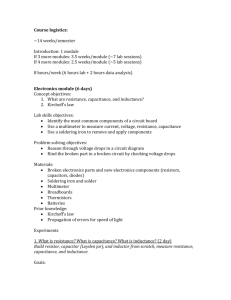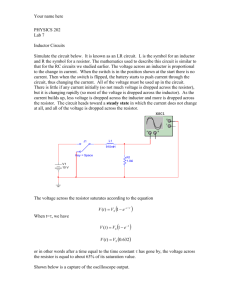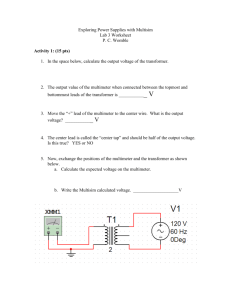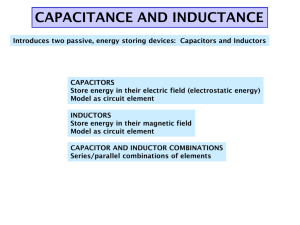PHYSICS 202 - La Salle University
advertisement
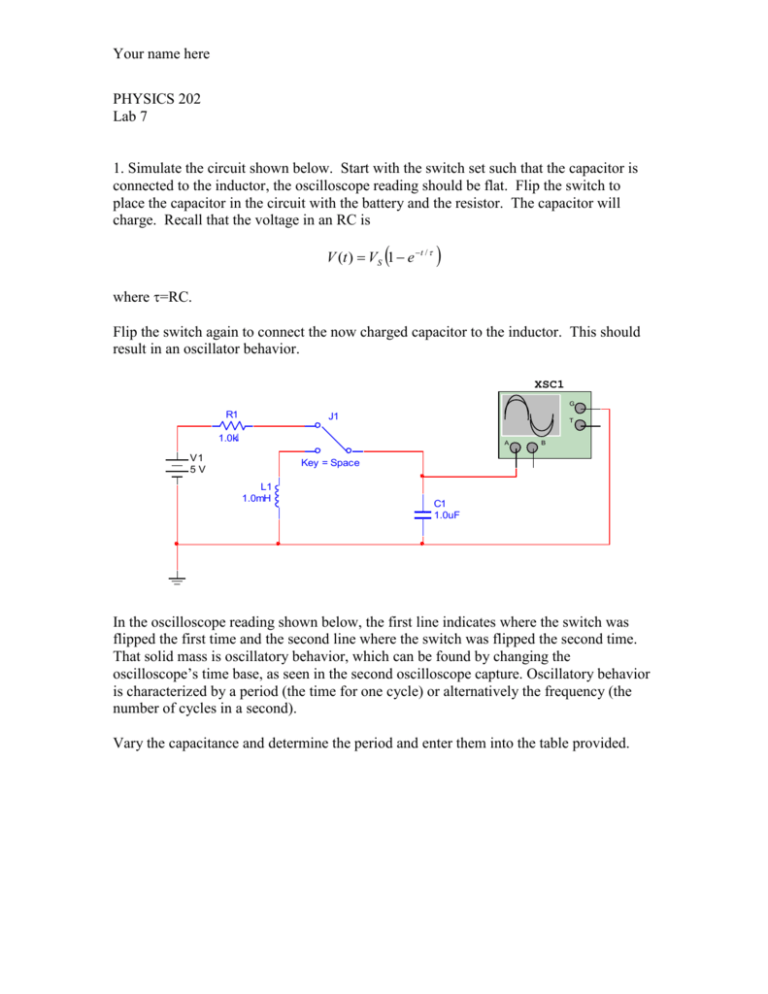
Your name here PHYSICS 202 Lab 7 1. Simulate the circuit shown below. Start with the switch set such that the capacitor is connected to the inductor, the oscilloscope reading should be flat. Flip the switch to place the capacitor in the circuit with the battery and the resistor. The capacitor will charge. Recall that the voltage in an RC is V (t ) VS 1 e t / where =RC. Flip the switch again to connect the now charged capacitor to the inductor. This should result in an oscillator behavior. XSC1 G R1 J1 T 1.0k A V1 5V B Key = Space L1 1.0mH C1 1.0uF In the oscilloscope reading shown below, the first line indicates where the switch was flipped the first time and the second line where the switch was flipped the second time. That solid mass is oscillatory behavior, which can be found by changing the oscilloscope’s time base, as seen in the second oscilloscope capture. Oscillatory behavior is characterized by a period (the time for one cycle) or alternatively the frequency (the number of cycles in a second). Vary the capacitance and determine the period and enter them into the table provided. Your name here Inductance L = 1 mH Your name here Capacitance ( ) Period ( ) Frequency ( ) Plot the period versus capacitance and fit it (Add a Trendline) to a power law. Paste the graph into your report. What power do you find? Power: Next vary the Inductance, determine the period and frequency. Capacitance C = 1 F Inductance ( ) Period ( ) Frequency ( ) Plot period versus inductance and fit it to a power law. Paste the graph into your report. What power do you find? Power: 2. We saw from the analysis above that a circuit with an inductor and a capacitor, an LC circuit, displays oscillatory behavior. This frequency is the so-called natural frequency to distinguish it from the driving frequency we are about to introduce into the circuit. In the circuit shown below we introduce a signal generator to the circuit. The signal generator will input an AC voltage, which has its own frequency. The circuit responds at the driving frequency; however, the size of the response depends on the proximity of the driving frequency to the natural frequency. The response grows dramatically in size if the driving frequency is close to the natural frequency. This phenomenon is known as resonance. The usual analogy is to a child on a swing. A child on a swing is a version of a pendulum, which has a natural frequency. If someone is pushing the child on the swing, then there is a driving force. If the driving force has the same frequency as the swing’s natural frequency, then one is always pushing the swing in the direction it is going naturally and the system gains energy, i.e. the child goes higher. If one were pushing at a different frequency, one would sometimes be working with, sometimes working against the child’s motion. The swing would not go very high. Resonance is important for tuning. Signals are placed on carrier waves and one must tune one’s receiver (change its natural frequency) to match the carrier’s frequency in order to Your name here receive a detectable signal. One is simultaneously blocking out other signals at other frequencies. Simulate the circuit above. Allow the output to settle into a sinusoidal form: i.e. measure toward the right in the picture below, not on the left. Determine the maximum (peak) voltage of the output signal for various driving frequencies (signal generator). Vary the frequency from 100 Hz to 200 Hz by steps of 5Hz and record the peak voltage seen on the oscilloscope. (If you build this in new Electronics Workbench, be sure to note that the capacitor is 1-mF not 1-F, you can find larger capacitor under the heading polarized capacitors.) Your name here Driving Frequency (Hz) 100 105 110 115 120 125 130 135 140 145 150 155 160 165 170 175 180 185 190 195 200 Peak Voltage (V) Plot peak voltage versus driving frequency. Paste it into your report. Verify that the largest signal is found for a frequency close to the natural frequency for the LC circuit found in the previous section.



![Sample_hold[1]](http://s2.studylib.net/store/data/005360237_1-66a09447be9ffd6ace4f3f67c2fef5c7-300x300.png)
